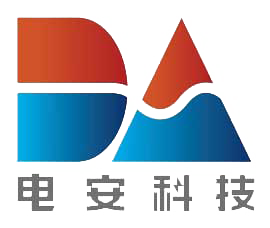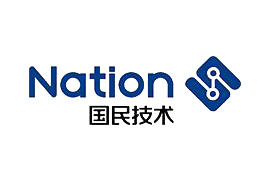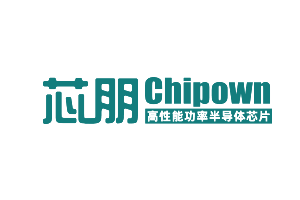
Driven by the electrification of automobiles, power electronic devices can be described as rising both in quantity and price. The development of power electronic devices has gone through the first stage with thyristor as the core and the second stage with MOSFET and IGBT as the representative. Now it is entering a new development stage with wide band gap semiconductor devices as the core.
The new generation of power electronic devices is also promoting the development of MOSFET and IGBT, which also drives the growing popularity of wide band gap semiconductors such as SiC and GaN. Electric vehicles have become the core application scenario of SiC. Therefore, we will focus on electric vehicles and discuss the application trend of SiC in electric vehicles with you.
Operating principle and advantages of EV
EV is the abbreviation of Electric Vehicle, also known as "electric vehicle". Originally, it was a general term for electric vehicles, but generally it only refers to cars.
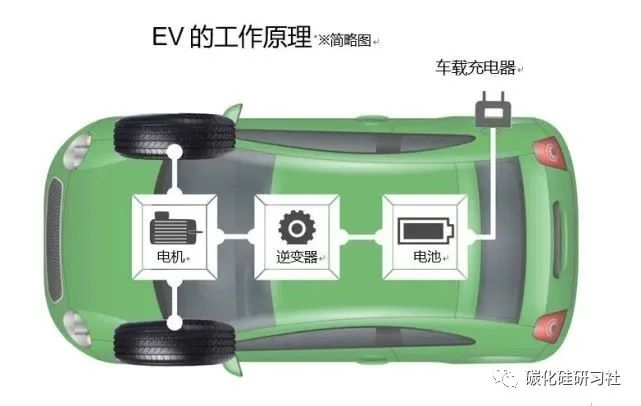
EV has four main elements
NO.1 On-board charger that converts domestic AC power supply to DC power supply
NO.2 Battery for storage of charging power
NO.3 Control the power from the battery and send it to the inverter of the motor
NO.4 Motor that converts the received power into power
Most traditional cars are equipped with engines, which use the energy generated by burning fuel to drive. EV uses electric power and motor instead of engine.
Advantages of EV
NO.1 Low fuel cost
EV uses electricity instead of gasoline. It is cheaper to charge electricity at night, so using night charging can make the electricity charge lower than the fuel charge.
NO.2 Environmental protection
Among cars, EV is classified as one of the "new generation of environmentally friendly cars" that are environmentally friendly to the earth. Because it does not emit any exhaust gas containing carbon dioxide and atmospheric pollutants, it helps to prevent global warming.
SiC power components are the key to EV
The sales volume of EV is increasing day by day, but in order to become more popular in the future, we need to solve the problem of how to use electricity effectively, which is the "SiC power components" made of SiC (silicon carbide) after the combination of Si (silicon) and C (carbon).
SiC power components are electronic products that are very suitable for "effective conversion of power", and can be used in EV vehicle chargers and battery inverters. SiC devices have lower conduction loss, higher working frequency and higher working voltage than Si devices.
Considering that electric vehicles in the future need longer driving distance, shorter charging time and higher battery capacity, SiC will be the future trend in automotive semiconductors. The application of SiC devices in EV/HEV mainly includes motor drive system inverter, power conversion system (on-board DC/DC), electric vehicle on-board charging system (OBC) and off-board charging pile.
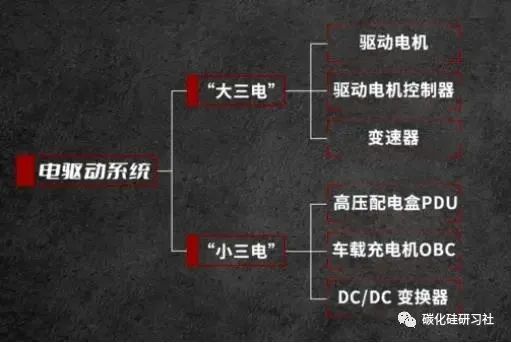
As the "heart" of new energy vehicles, electric drive system directly affects the energy efficiency and range of the whole vehicle. It has a great impact on the service performance of new energy vehicles.
Under the current trend of integration, the "three in one" electric drive module integrated with motor+reducer+inverter will become the mainstream of the market. The electric drive integrated system will accelerate the mass production of SiC devices in electric vehicles.
Although the cost of silicon carbide devices is high, it has promoted the reduction of battery cost and the improvement of range, and reduced the cost of single vehicle. It is undoubtedly the best choice for new energy vehicles. Among them, SiC SBD and SiC MOSFET devices are mainly used for OBC and DC/DC, and SiC MOSFET devices are mainly used for electric drive.
Influence of SiC on main inverter
The main inverter is also the traction inverter. Its function is to convert the electric energy (DC) from the battery to drive the electric engine (AC). Therefore, the performance, volume and weight of the inverter will directly affect the range and reliability of the vehicle.
At present, the main drive inverters in electric vehicles are still based on silicon-based MOSFETs and silicon-based IGBTs. However, with the development of new energy vehicles to high integration, small size and low loss systems, SiC devices will accelerate the penetration.
Compared with silicon-based devices, after introducing silicon carbide, the output power of the inverter can be increased to 2.5 times, the volume can be reduced by 1.5 times, and the power density is 3.6 times.
Influence of SiC on on-board charger (OBC)
On-board charger (OBC) provides the key function of charging the high-voltage DC battery pack of electric vehicle (EV) from the infrastructure grid, and determines the key components of charging power and efficiency. The battery can be charged by converting the AC power in the power grid into DC power by using the on-board charger.
In addition, bidirectional inverter technology is one of the standard functions of OBC in the future, which enables OBC not only to convert AC into DC for battery charging, but also to convert battery DC into AC for external power output; Functional integration of OBC, DC/DC and other devices will improve the cost and volume advantages.
SiC diodes and MOSFET devices can be used in the PFC and DC-DC secondary rectification links of vehicle chargers, and promote the development of vehicle chargers towards two-way charging and discharging, integration, intelligence, miniaturization, lightweight, high-efficiency and other directions.
*Taking 22kW bidirectional OBC as an example, the cost of SiC system is reduced by 15% compared with Si; At the same time, the energy density is 1.5 times that of the Si system, and the unit cost can be reduced by about $40 per year by reducing energy consumption.
Influence of SiC on DC/DC converter
Power conversion system DC/DC is a voltage converter that converts input voltage and effectively outputs fixed voltage to realize power conversion between high-voltage battery and low-voltage battery in the vehicle. With the development of vehicle intelligence and electrification, higher requirements are put forward for the power supply and safety of DC/DC.
It is worth mentioning that the power device developed based on silicon carbide brings revolutionary innovation to the DC/DC converter of hydrogen vehicle fuel cell. It realizes the miniaturization of the system and lower loss, thus achieving faster charging speed.
Compared with the traditional IGBT-based modular converter products, the switching frequency of SiC-based power devices is increased by more than 4 times, the power density is increased by more than 3 times, the average efficiency of the system is greater than 97%, and the maximum efficiency is up to 99%.
In new energy vehicles, silicon-based power devices have cost advantages and will still occupy a certain market share, and coexist with wide bandgap semiconductor devices for a long time.
In the future, silicon-based IGBT modules and SiC modules will also become the main application forms in new energy vehicle semiconductors. Compared with silicon-based devices, the balance between high technology, high performance and cost of SiC power semiconductors will become the key point for the large-scale implementation of SiC power devices.
Note: The text is reproduced to Silicon Carbide Research Institute for sharing only.















